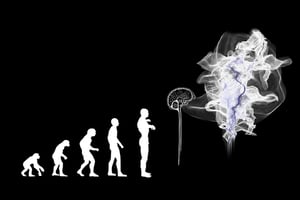The 1995 movie Johnny Mnemonic, starring Keanu Reeves, tells a story about a data courier named...
Science Can Predict Future Behavior—Should it?
Minority Report was a science fiction story written by Philip Dick and adapted for the 2002 blockbuster film starring Tom Cruise. Imagining the world by year 2054, Philip Dick portrayed a government body with an ability to predict crimes before they happened, and the right to arrest individuals based on their potential of committing a “future crime.” When the movie hit theaters, the idea of predicting crimes seemed a preposterous notion, but science often makes the seemingly impossible, reality.
One of artificial intelligence’s main contributions to date is in predictive analysis—using pattern recognition to identify future possibilities. It is an exciting field and has already been used to predict potential illnesses in individuals far in advance. It give them time with the help of a doctor to take preventative or at least measure to reduce the impacts of the disease.
AI is also being used in facial recognition and for self-driving cars. In both applications AI attempts to recognize objects based on patterns. Police departments around the world are working to use the technology to identify criminals and terrorists using camera systems tied into an AI system. The idea is to spot crime before it happens. The three applications of AI have the potential to help people live longer, reduce crime, and create autonomous vehicles with the ability to drive nearly anywhere.
Augmented intelligence uses brain-machine devices to harness technology through thoughts, bringing science one step closer to predicting the electromagnetic signals in the brain.
Predicting human behavior is the holy grail of AI research. Using software to discern complex patterns of probable outcomes is a strategy many companies are already pursuing, particularly for detecting financial fraud, market movements, or even unexpected world events. AI technology is moving forward quickly. Recently, scientists came to a startling conclusion after studying active human brain scans—they were able to predict an individual’s propensity to commit a crime based on the patterns of brain activity.
![]() Behavior modeling is not an exact science and, in the past, tended to focus on wide trends and group averages rather than individual behavior. Determining why individuals choose one action over another was hidden within the complexities of the mind function—until now.
Behavior modeling is not an exact science and, in the past, tended to focus on wide trends and group averages rather than individual behavior. Determining why individuals choose one action over another was hidden within the complexities of the mind function—until now.
Criminologists, psychologists and scientists have long studied human motivation and decision making based on behavioral patterns of groups, but their predictions were notoriously inaccurate when applied to individuals because of the wide variations in human behavior. Brain scans allow them to identify physiological signs in an individual that predict behavior. The exact thought patterns of an individual predict their future criminal behavior. The implication is clear—criminals can be identified in advance of their crimes based on how their minds work.
Researchers posit that the brain scans of children and infants foreseeably identify the individuals with a higher propensity to commit violent crimes. Such scans could put valuable information in the hands of parents and educators to intervene before criminal behaviors manifest.
But like many technological advances with applications to further the good of mankind, there is a dangerous downside. Much like splitting the atom gave the world near unlimited carbon-free electricity, it also gave us atomic bombs, the arms race and the potential for planetary destruction.
AI poses extraordinary risk of misusing the information it provides.
Imagine the potential societal damage of making medical information or facial recognition widely available. It could be used to discriminate among job candidates, deny insurance coverage to certain individuals, or decide which inmates will receive parole. It could also be used to track innocent citizens with the push of a button. Access to AI as it applies to brain scans has an even greater potential for abuse. Government agencies could potentially target individuals based on their scans and declare them as “hostiles.”
Take for example the US government’s crackdown on Japanese citizens living on the west coast during WWII; even when there was no evidence of criminal activity, Japanese immigrants were tagged by the US as potential threats and moved into internment camps. Recently uncovered abuses of the Patriot Act and FISA warrants in the US are another concern. Privacy and the right to move freely without government monitoring is potentially at risk.
Like many scientific advancements, artificial intelligence has both the chance to create a bright future for the world, and the power to execute widespread oppression. AI is changing our world for the better or a terrifying alternative.
TOP SECRET: TACTICS FOR ULTIMATE MIND CONTROL
Should you choose to accept this mission here is the quick-start guide.
This message will self-destruct in . . 3 . . 2 . .1




